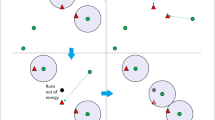Abstract
Because of limited battery equipped on each sensor, power consumption is one of the crucial issues in wireless sensor networks (WSNs). It therefore has been the focus of many researchers. An important problem concerning power consumption is to minimize the number of maximum-power nodes while maintaining a desired network topology. As fault tolerance is vitally important in practice, it is desirable that the constructed network topology is \(k\)-edge-connected or \(k\)-connected. In this paper, we study the dual power assignment problem for \(k\)-edge connectivity \((kEDP)\) and biconnectivity in WSNs. While other studies consider only the special case \(k=2\), our goal is to address the general problem. In addition to showing the APX-completeness of biconnectivity problem in the metric model, we also prove the NP-completeness of the \(kEDP\) problem in the geometric case and provide a 2-approximation algorithm using linear programming techniques. To the best of our knowledge, this approximation ratio is currently the best one. We also introduce a heuristic whose performance is better compared with an approximation algorithm in Wang et al. (J Comb Optim 19:174–183, 2010).











Similar content being viewed by others
References
Calinescu G, Wen PJ (2006) Range assignment for biconnectivity and k-edge connectivity in wireless ad hoc networks. Mob Netw Appl 11(2):121–128
Chen J-J, Lu H-I, Kuo T-W, Yan C-Y, Pang A-C (2005) Dual power assignment for network connectivity in wireless sensor networks. In: GLOBECOM ’05. IEEE, vol 6, pp 5–3642
Cormen TH, Stein C, Rivest RL, Leiserson CE (2001) Introduction to algorithms, 2nd edn. McGraw-Hill Higher Education, New York
Diestel R (2000) Graph theory. Springer, Berlin
Duh R-c, F ürer M (1997) Approximation of k-set cover by semi-local optimization. In: Proceedings of the twenty-ninth annual ACM symposium on theory of computing. ACM, New York, NY, USA, pp 256–264
Dyer M, Frieze A (1986) Planar 3DM is NP-complete. J Algorithms 7(2):174–184
Jain K (1998) A factor 2 approximation algorithm for the generalized steiner network problem. In: Proceedings of the 39th annual symposium on foundations of computer science, pp 448–457
Jarray F (2011) An iterative exact solution for the dual power management problem in wireless sensor network. J Math Model Algorithms 10(2):205–212
Kirousis LM, Kranakis E, Krizanc D, Pelc A (2000) Power consumption in packet radio networks. Theor Comput Sci 243(1–2):289–305
Lam NX, Nguyen TN, An M-K, Huynh DT (2011) Dual power assignment optimization for k-edge connectivity in WSNs. In: IEEE SECON 2011, pp 566–573
Lloyd EL, Liu R, Marathe MV, Ramanathan R, Ravi SS (2005) Algorithmic aspects of topology control problems for ad hoc networks. Mob Netw Appl 10(1–2):19–34
Lloyd EL, Liu R, Ravi SS (2006) Approximating the minimum number of maximum power users in ad hoc networks. Mob Netw Appl 11(2):129–142
Park M-A, Wang C, Willson J, Wu W, Farago A (2006) Fault- tolerant dual-power assignment in wireless sensor networks (Technical Report Nos. UTDCS -52-06). University of Texas at Dallas Computer Sciences Department
Poojary N, Krishnamurthy S, Dao S (2001) Medium access control in a network of ad hoc mobile nodes with heterogeneous power capabilities. In: IEEE international conference on communications (ICC), vol 3, pp 872–877
Regina RR, Rosales-hain R (2000) Topology control of multihop wireless networks using transmit power adjustment. In: IEEE INFOCOM, vol 2, pp 404–413
Rong Y, Choi H, Choi H-A (2004) Dual power management for network connectivity in wireless sensor networks. In: International parallel and distributed processing symposium, p 225
Shah V, Krishnamurthy S, Poojary N (2004) Improving the mac layer performance in ad hoc networks of nodes with heterogeneous transmit power capabilities. In: 2004 IEEE international conference on communi- cations, vol 7, pp 3874–3880
Valiant LG (1981) Universality considerations in VLSI circuits. IEEE Trans Comput 30(2):135–140
Wang C, Park M-A, Willson J, Cheng Y, Farago A, Wu W (2008) On approximate optimal dual power assignment for biconnectivity and edge-biconnectivity. Theor Comput Sci 396(1–3):180–190
Wang C, Willson J, Park M-A, Farago A, Wu W (2010) On dual power assignment optimization for biconnectivity. J Comb Optim 19:174–183
Author information
Authors and Affiliations
Corresponding author
Additional information
This paper is a revised and expanded version of Lam et al. (2011). It contains the APX-completeness proof for the bi-connectivity problem in the metric model.
Rights and permissions
About this article
Cite this article
Lam, N.X., Nguyen, T.N., An, M.K. et al. Dual power assignment optimization and fault tolerance in WSNs. J Comb Optim 30, 120–138 (2015). https://doi.org/10.1007/s10878-013-9637-5
Published:
Issue Date:
DOI: https://doi.org/10.1007/s10878-013-9637-5




